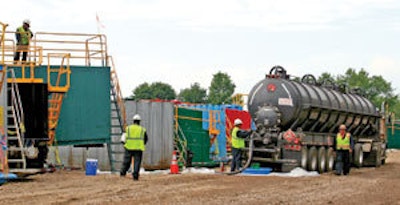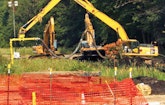Interested in Cleaning?
Get Cleaning articles, news and videos right in your inbox! Sign up now.
Cleaning + Get AlertsLast July, a 30-inch pipe transporting crude oil from Griffith, Ind., to Sarnia, Ontario, Can., began leaking near the pump station at Marshall, Mich.
An estimated 20,082 barrels (843,444 gallons) of oil leaked from the pipeline; of that, an estimated 8,033 barrels (337,386 gallons) entered Talmadge Creek and Kalamazoo River. Fearing the spill would reach Morrow Lake, an impoundment above a hydroelectric dam on the river, Enbridge Energy Partners, L.P., set up containment booms before the lake and deployed multiple vacuum trucks upstream to collect oil.
Officials, realizing the spill’s extent, called Steve Taplin, chief executive officer of Terra Contracting LLC, a remediation contracting company in Kalamazoo, Mich. He ordered the initial wave of equipment and personnel while driving the 40 miles to Marshall.
“Representatives took me to the first location and the sight was overwhelming,” says Taplin. “It had rained heavily that weekend and water in the creek was flying past. I immediately ordered more of everything.”
Enbridge, working under the direction of the U.S. EPA and the Michigan Department of Natural Resources and Environment (MDNRE), soon instituted a nonstop operation with many major contractors and dozens of subcontractors. Taplin’s crew placed containment booms, vacuumed or transported oil, water, and oil-water mixtures, responded with identical action to a second spill, and decontaminated most of the cleanup equipment. Four months later, clear water flowed again in the creek and river. The oil never reached Morrow Lake.
EARLY HOURS
When Taplin saw the expanse of work, he called in people and equipment from six projects around the country. The jobs remained shut down for two weeks.
During the first few hours, Taplin stationed crews at five sites around Marshall. They operated a dozen 3,000-gallon vacuum loaders from Presvac Systems Ltd. or Wastequip Cusco Inc.; two 6,000-gallon stainless steel vacuum tankers, one each from Acro Trailer Co. and Brenner Tank LLC; and a 7,000-gallon and 6,700-gallon bulk tanker from Polar Tank Trailer. The bulk tankers have no pumps.
“The vacuum tankers would discharge into the bulk tankers, then return to pumping oil from the creek and river,” says Taplin. “The bulk tankers transported the oil-water to the growing frac tank farm for loading. We worked 12-hour shifts and the trucks never stopped running.” By that weekend, 100 Terra employees were on site. Needing more, Taplin hired staff or tapped key subcontractors for extra people.
The confluence of Talmadge Creek and the Kalamazoo River was a key containment site. “It’s a small creek, so with EPA approval we put in row after row of boom angled to direct the oil to shore,” says Taplin. Six hundred feet of boom and six vacuum trucks were deployed at the confluence.
Meanwhile, Enbridge set up 20,000-gallon portable frac tanks at the small pump station. Taplin offered to run the tank farm, provide all paperwork, and coordinate shipments of oil and oil-water mixtures to the Enbridge facility in Griffith, Ind. “Our tankers ran 24/7 because we could switch drivers at our Kalamazoo facility,” says Taplin. “My crew also unloaded all the arriving trucks and loaded the tankers going to Griffith.”
EXPANSION
The pump station had a 15-foot-wide service road 1,000 feet long. By the third day, inbound and outbound tankers, the arrival of more frac tanks, and a major rainstorm created traffic jams. Enbridge hired a contractor to build roads and expand the area to accommodate 128 frac tanks. Taplin assumed command of fugitive dust management, including watering roads and sweeping streets.
To integrate road construction with tank farm activities, Taplin brought in a portable radio tower and equipped his people with radios. They numbered tanks and marked their locations on a map. “We tracked everything very closely,” he says. “It was a logistics nightmare.”
As cleanup progressed, the water in the oil-water mixture increased beyond the percentage accepted by the Griffith facility. “Frac tanks have valves at various levels for dewatering,” says Taplin. “My people installed a length of clear tubing in the vacuum hose so they could close the valve as soon as they saw oil coming through.”
The water, stored in specific frac tanks, was filtered through a carbon treatment system to remove dissolved hydrocarbons before being transported to a nonhazardous disposal facility. Oil skimmed from the frac tanks was consolidated in different tanks for transport to Griffith.
“I had six 3,000-gallon vacuum trucks just pulling water and skimming oil,” says Taplin. “In one shift, tankers brought in 275,000 gallons.” To improve efficiency, Taplin’s men built a header system using hundreds of feet of hose, valves, and clear tubes to pump water to the carbon treatment unit and free the badly needed vacuum trucks.
NOTABLE ACHIEVEMENTS
Meanwhile, a crew at Heritage Park on the east side of Battle Creek skimmed oil nonstop using one of three Vactor combination sewer cleaning machines from Federal Signal Corp. They worked for more than a month to remediate the site, one of the first to pass inspection.
A notable contribution to the cleanup was Terra’s Sed-Vac, a system that works with a Guzzler industrial vacuum loader pulling 5,300 cfm at 28-inch Hg. It enables crews to reach out into a waterway and vacuum oil off the surface.
“We run the 8-inch vacuum hose to a special head that replaces the bucket on our long-reach – 65 feet – Komatsu excavator,” says Taplin. “The head has a horizontal metal pipe for attaching the hose, then a 90-degree fitting to a vertical pipe.”
The Sed-Vac worked at a flume – pipes that allowed the creek to flow through, but trapped the oil. The Guzzler ran continuously for two weeks, while vacuum loaders pulled off the oil and transported it to the tank farm.
“Enbridge didn’t mess around when it came to repairing the pipe,” says Taplin. “The infrastructure they built to reach the marshy area was awesome. They cut trees and shrubs, then laid thousands of 4- by 25-foot-long hardwood crane mats 12 inches thick for roads.”
The Sed-Vac worked alongside the excavators as they dug a sizable hole 10 feet deep to expose the broken line. Taplin then replaced the Guzzler with two Vactor 2100 PD combination machines to keep the hole dry as workers drove in sheet piling and replaced the bad section. The operation took two weeks.
Oil that sat for a while sank. A subcontractor dredged the submerged contaminated sediment and dewatered it in synthetic tubes. Meanwhile, Taplin’s crew ran the collected water through a treatment plant before pumping it into the river.
In September, Enbridge had a smaller oil spill in Romeoville, Ill. Taplin dispatched 30 employees and equipment to do the same duties. They finished in late October.
WINDING DOWN
Every piece of equipment used in the cleanup was decontaminated. Taplin assigned 40 men to run the largest of the operations. Cleaning crews used a high-pressure trailer-mounted waterblaster from NLB Corp. A multi-gun valve enabled them to run nine lances simultaneously, with the machine pumping 50 gpm at 3,500 psi. A boiler heated the water to 100 degrees Fahrenheit, then cleaning solution was incorporated into the flow.
“Everything received a tracking number so owners could reclaim it,” says Taplin. “My people were constantly moving equipment in and out. They even repackaged and shrink-wrapped booms for pickup.” Work on the site was still ongoing as of late January 2011.








